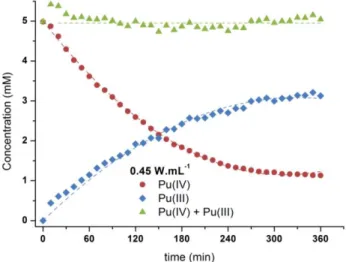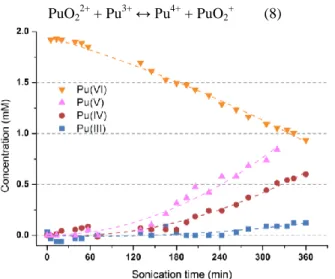HAL Id: cea-02920124
https://hal-cea.archives-ouvertes.fr/cea-02920124
Submitted on 24 Aug 2020
HAL is a multi-disciplinary open access
archive for the deposit and dissemination of
sci-entific research documents, whether they are
pub-lished or not. The documents may come from
teaching and research institutions in France or
abroad, or from public or private research centers.
L’archive ouverte pluridisciplinaire HAL, est
destinée au dépôt et à la diffusion de documents
scientifiques de niveau recherche, publiés ou non,
émanant des établissements d’enseignement et de
recherche français ou étrangers, des laboratoires
publics ou privés.
Redox Reactions of Pu ions in Aqueous Nitric Solutions
under Ultrasound Irradiation
Matthieu Virot, L. Venault, Philippe Moisy, Sergey I. Nikitenko
To cite this version:
Matthieu Virot, L. Venault, Philippe Moisy, Sergey I. Nikitenko. Redox Reactions of Pu ions in
Aqueous Nitric Solutions under Ultrasound Irradiation. Plutonium Futures - The Science 2014, Sep
2014, Las vegas, United States. �cea-02920124�
Redox Reactions of Pu ions in Aqueous Nitric Solutions under Ultrasound Irradiation
Virot M.,1 Venault L.,2 Moisy P.,2 Nikitenko S. I.1
1 ICSM-UMR5257 CNRS/CEA/UM2/ENCSM, Site de Marcoule, 30207 Bagnols/Cèze, France ; 2 CEA/DEN/DRCP, Radiochemistry and Process Department, 30207 Bagnols/Cèze, France. Email: matthieu.virot@cea.fr
INTRODUCTION
In France, industrial reprocessing of spent nuclear fuel involves the dissolution of the irradiated fuel in concentrated nitric media in view of the recycling and separation of uranium and plutonium. Among others, the current treatment of spent fuel raises the questions of waste and effluent management. With the aim of preparing future GENIV reactors and answering to the world demand in the development of a more sustainable nuclear energy, new alternatives are nowadays investigated [1,2]. Sonochemistry, which studies the influence of ultrasonic waves on chemical systems, has been showed to enhance chemical yields and accelerate reaction rates for several homogeneous and heterogeneous systems [2,3]. The aim of the present study is to evaluate the potential of high-power ultrasound towards the control and stabilization of Pu oxidation states in aqueous nitric solution.
DESCRIPTION OF THE ACTUAL WORK
Aqueous nitric solutions of Pu(III), Pu(IV), and Pu(VI) were submitted to 20 kHz ultrasound irradiation (0.28 – 0.52 W mL-1) under Ar atmosphere. Experiments were carried out in Atalante facility (Marcoule) in a dedicated glove box allowing the control of the temperature in the home-made reactor during the whole experiments (25-29°C). The acoustic power delivered to the solution was assessed by using the calorimetric method. The behavior of the sonicated Pu solutions was studied in 1 M HNO3 and was followed by using the
UV-Vis-NIR spectrophotometer connected to the glove box. Pu(VI), Pu(V), Pu(IV) and Pu(III) were respectively followed at 831 nm (ε= 530 cm-1M-1), 568 nm (ε= 19 cm
-1M-1), 476 nm (ε= 67 cm-1M-1), and 602 nm (ε= 30 cm-1
M-1). The formation rate of H2O2 during sonolysis was
determined by colorimetric method: sampled solution aliquots were diluted with a 2.10-2 TiOSO4 solution, and
the formation of a [Ti(IV)H2O2] complex was followed at
410 nm (ε= 730 cm-1M-1).
RESULTS
The sonication of pure water under Ar is known to generate H2 and H2O2 species resulting from the
recombination of radical products formed by the homolytic dissociation of H2O molecules [2]. Previous
investigations demonstrated that the sonication of aqueous
nitric solutions leads to the formation of NO and NO2 in
the gas flow, and the accumulation of HNO2 in solution
[3,4]. Using these conditions, H2O2 cannot accumulate
due to its rapid reaction with HNO2 according to the
reaction 1. In the presence of anti-nitrous reagents, the accumulation of H2O2 becomes possible and is even
higher than what usually observed in pure water for similar conditions. This phenomenon results from the reaction of OH• radicals with nitrate ions, followed by their hydrolysis (reactions 2-3) [5]. In this mechanism, only one HO• radical is used to produce one H2O2
molecule, while two HO• are needed in pure water. HNO2 + H2O2 → HNO3 + H2O (1) HO• + H+ + NO3- → NO3 • + H2O (2) NO3 • + H2O → NO2 + H2O2 (3)
The sonolysis of various Pu solutions was studied in diluted aqueous nitric solutions (20 kHz, Ar, 1 M HNO3).
The ultrasonic treatment of such a solution has no effect on Pu(IV). By contrast, Pu(III) is found to be rapidly oxidized to Pu(IV) in similar conditions. The reaction mechanism involves the catalytic oxidation of Pu(III) with nitrous acid generated by nitric acid sonolysis. In the presence of sulfamic acid or hydrazinium nitrate as anti-nitrous reagents (reactions 4-5), Pu(IV) is found to be reduced to Pu(III) during ultrasound irradiation (Fig 1). The reaction kinetics follows a first order reaction law and is highly dependent upon the acoustic power delivered to the solution.
Fig. 1. Sonolysis (20 kHz, 0.45 W mL-1, Ar, V= 50 mL) of a 5 mM Pu(IV) solution in 1 M HNO3 / 0.1 M
Pu(IV) reduction is not complete and leads to a steady state where Pu(IV) and Pu(III) are both coexisting in solution. In the presence of Pu ions, the absence of H2O2 in sonicated solutions was evidenced by UV-Vis
spectroscopy. In agreement with the literature, the decrease of Pu(IV) concentration during sonolysis can be attributed to its reduction reaction with the in-situ generated H2O2 (reaction 6) [6]. Investigations showed
that the steady state is explained by the partial back oxidation of Pu(III) with H2O2 in agreement with the
reaction (7).
2 HNO2 + N2H5+ → N2O + N2 + 3 H2O + H+ (4)
HNO2 + NH2SO3H → H2SO4 + N2 + H2O (5)
2 Pu4+ + H2O2 → 2 Pu3+ + O2 + 2 H+ (6)
2 Pu3+ + H2O2 + 2 H+ → 2 Pu4+ + 2 H2O (7)
The concentration of Pu(VI) in diluted aqueous nitric solution in the presence of sulfamic acid is also found to decrease during sonication. The reduction reaction leads to Pu(V) accumulation (Fig. 2) and can be attributed to the in-situ formation of H2O2 [6]. Note that Pu(V) is
normally unstable in these conditions but is found to accumulate as a result of the continuous Pu(VI) reduction by ultrasound. For prolonged sonication, the presence of Pu(IV) resulting from Pu(V) disproportionation is evidenced. Furthermore, the kinetics related to Pu(VI) reduction are found to increase with sonication time. This phenomenon could be explained by the reduction of Pu(IV) to Pu(III) with H2O2 in agreement with the above
described results. Pu(III) could then react with Pu(VI) according to the well-known equilibrium described in the reaction (8), and therefore explain the acceleration of Pu(VI) reduction rate during sonication.
PuO22+ + Pu3+ ↔ Pu4+ + PuO2+ (8)
Fig. 2. Sonolysis (20 kHz, 0.48 W mL-1, Ar, V= 50 mL) of a Pu(VI) solution in 1 M HNO3 / 0.1 M NH2SO3H.
Pu(V) and Pu(IV) concentrations are increasing with sonication duration (Pu(III) signal has to be confirmed).
Sonochemistry appears to be an interesting and valuable tool for the control and stabilization of actinide species in solution. The procedure allows working under controlled kinetics by generating active species directly in the solution without any additional chemicals. Sonication is in addition performed in dilute nitric solutions at almost room temperature what can be of particular interest in nuclear processing. Further experiments are currently under investigation to enhance kinetics.
REFERENCES
1. V. I. MARCHENKO, K. N. DVOEGLAZOV, V. I. VOLK, “Use or Redox Reagents for Stabilization of Pu and Np Valence Forms in Aqueous Reprocessing of Spent Nuclear Fuel: Chemical and Technological Aspects,”
Radiochem., 51, 329 (2009).
2. S. I. NIKITENKO, L. VENAULT, R. PFLIEGER, T. CHAVE, I. BISEL, Ph. MOISY, “Potential Applications of Sonochemistry in Spent Nuclear Fuel Reprocessing: a Short Review,” Ultrason. Sonochem., 17, 1033 (2010). 3. H. XU, B. W. ZEIGER, K. S. SUSLICK, “Sonochemical Synthesis of Nanomaterials,” Chem. Soc.
Rev., 42, 2555 (2013).
4. L. VENAULT, Ph. MOISY, S. I. NIKITENKO, C. MADIC, “Kinetics of Nitrous Acid Formation in Nitric Acid Solutions under the Effect of Power Ultrasound,”
Ultrason. Sonochem., 4, 195 (1997).
5. S. I. NIKITENKO, L. VENAULT, Ph. MOISY, “Scavenging of HO• Radicals Produced from H2O
Sonolysis with Nitrate Ions,” Ultrason. Sonochem., 11, 139 (2004).
6. D. L. CLARK, S. S. HECKER, G. D. JARVINEN, M. P. NEU, The Chemistry of the Actinide and Transactinide
Elements, p. 813, L. R. MORSS, N. EDELSTEIN, J.
FUGER, J. J. KATZ, Eds., Springer, Dordrecht, Netherlands (2011).

